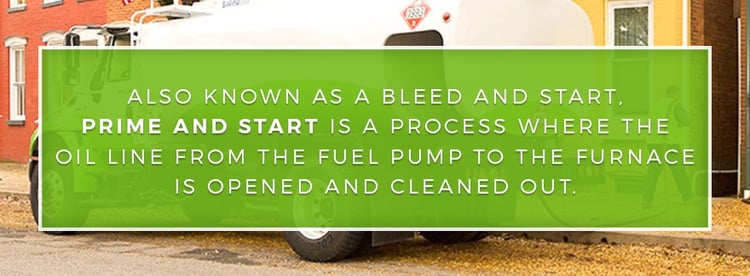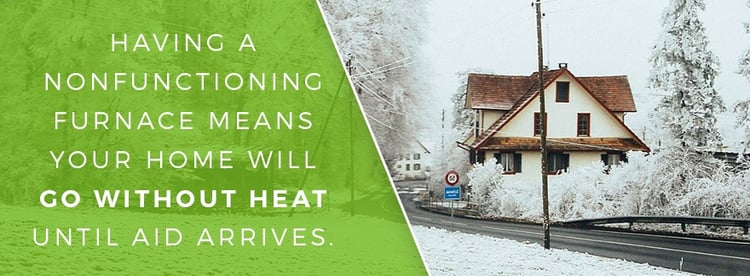
In our busy daily lives, we can often let household maintenance go by the wayside. It could be dishes, laundry or a good floor cleaning. For homeowners with an oil-based heater, getting heating oil for your furnace is also often on that list. Whether you simply forget to refill it or try to use every last drop of oil before your next delivery, letting your oil furnace run low can be risky, both to your furnace and to the quality of your home’s heat. If your furnace runs low, you may be risking it running dry.
If you run out of oil in your oil-burning furnace, it can cause a few problems. You may find that air and sludge from the bottom of your empty tank have gotten into your oil lines, making it more difficult for your furnace to restart. In some cases, your furnace or boiler will restart on its own once you refill your oil tank. However, if it doesn’t, you’re going to want to give a call to your chosen maintenance professionals for a priming.
How Can You Determine If Your Furnace Is out of Oil?
Before you give a call to your preferred oil furnace technician, you should make sure your furnace actually ran out of oil before you request a prime and start. If there is still oil in your tank, it can indicate other problems with your furnace, which may require different services.
To tell if your furnace is indeed out of oil, you’ll first want to find the oil tank gauge. For a basement tank, this will be on the top, while an in-ground tank will have the gauge or another type of indicator on a wall in or on your home. The gauge will typically give you a readout of how much oil is in the tank. If it is on empty, the reader needle will be at the empty mark — which could be a “0” or an “E.”
If your tank is indeed empty, refill it with some oil and try to restart it before calling a technician. In some cases, this will work just fine. However, if the furnace doesn’t restart when you attempt, you may need to contact your technician for a prime and start. Let them know of the reading before you refilled the tank, what you tried to do and what happened.
What Is a Prime and Start?

Also known as a bleed and start, prime and start is a process where the oil line from the fuel pump to the furnace is opened and cleaned out. This is usually done by letting the oil pump through for a few minutes before redirecting it to the furnace. This process helps to clean out the oil line for air and sludge, which can block the oil line and prevent proper function.
How Does Priming an Oil-Burning Furnace Work?
You should first try to press the ‘reset button’ on your furnace yourself before calling your technician. In some models, the furnace is able to bleed itself, making the prime and start process much simpler for you. However, if this doesn’t start your furnace, or if your furnace does not have a reset button, you should immediately consult a professional to properly prime and start your oil furnace. They can look at your furnace, troubleshoot and diagnose any problems and help get your furnace up and running again in no time.
To give you a basic understanding of how the prime and start process works, and what it involves, we’ve outlined the basic steps below:
- Basic checks: Typically, your oil furnace maintenance professional will take a look at your furnace before trying to start and prime it. If the sludge and air from the bottom of your fuel pump got far enough into the oil line, it can take additional measures to ensure your oil line gets cleared and your furnace starts properly. Generally, the process will involve attempting to restart the furnace a few more times and looking at the furnace from several angles to ensure all parts are in order. Once the technician is confident there are no other physical problems with the furnace, they can decide on the proper way to proceed.
- Turn off the power: Turning off your furnace is the first step of the prime and start process and is important to ensuring the procedure goes as planned. There should be a toggle switch next to the furnace for controlling the power, though each model is designed slightly differently. Some models may not have a switch, or you or the technician may not be able to locate it. In this case, the power to the furnace will need to be completely shut off by turning off the furnace breaker inside your home's main circuit breaker box.
- Check the thermostat: Your technician will probably check the thermostat for your furnace to make sure it is on and set to a temperature higher than your home's current ambient temperature. The difference between this setting and the ambient temperature will send a signal to the furnace, indicating it needs to turn on to raise the temperature in your home.
- Find the bleeder valve: Next, the technician will need to find the bleeder valve on your fuel pump. This is similar to the bleeder valve on your car's brake system, and it serves a similar purpose. This bleeder valve typically sits on the side or on the front of the fuel pump. It usually looks like a hex nut sticking out from the surface of the pump, and it is appropriate for a 3/8-inch wrench.
- Loosen the valve: The technician will either place some type of container beneath the bleeder valve before loosening the valve, or they will attach some tubing to the bleeder and lead it to a container placed on the floor. Typically, a one-gallon container, such as a bucket, is sufficient to hold the amount of fuel bled during this procedure. Plastic containers are generally avoided in favor of metal containers since oil dissolves plastic, and long-term contact between the oil and plastic can destroy the integrity of the container. A metal container will save your floor from any dripping fuel as the oil line is bled.
- Turn on the power: Whether the technician flipped a switch or turned off the furnace breaker, the next step requires the furnace to be turned back on. During this process, the technician will need to keep an eye on the valve to make sure the bleeding process starts out properly. During this step, you should be prepared for air and fuel to sputter from the valve. Once this dies down, the technician will press the red reset button to restart the furnace. This will cause fuel to begin to pump through the line again.
- Let it bleed: Leave the bleeder valve open until the stream it releases is steady and consistent. This may take longer depending on the amount of sludge and air in the oil pipe. Your technician will decide when the stream is steady enough to try and restart your furnace again. At this point, they will close the valve, which should turn the furnace on automatically. You’ll be able to tell when the furnace turns on because you’ll hear a sudden thump and a dull roar as it starts burning. You’ll also be able to see light in the pilot window.
If the furnace does not turn on, this typically means there is still a blockage in the line. The technician will check for other sources of error, then loosen the bleeder valve again to try and get the blockage out. They’ll typically repeat this process if the furnace still won’t restart. Sometimes, it can take five or six attempts before the furnace turns back on again.
- Re-pour the fuel: Once the furnace is started and running smoothly, you are good to go. However, do not just throw away the fuel you captured from the bleeder valve — that’s some expensive waste! You’ll want to pour that captured fuel back into your oil furnace fuel tank.
What If the Line Won’t Bleed?

If your technician has completed all steps properly and the line simply won’t bleed, this indicates a more complex problem with your system. It can indicate any of the following problems with your pump:
- Clogged filter: Sometimes, your filter may be clogged enough to prevent any fuel from moving through the system. The filter is typically a black canister with a red top, found suspended by the fuel lines near the tank or furnace. Your technician will typically fix this by loosening the filter and letting it bleed a bit before closing it again.
If this bleed doesn’t help, the filter might need to be changed entirely. This is a simple enough process and new oil filters are fairly inexpensive. Your technician will typically hold the filter over a container to catch fuel while they loosen the filter and remove the felt and mesh inside. While replacing the filter, they will typically replace any seals and gaskets as well to ensure the optimal function of your filter.
- Damaged fuel line: Sometimes the fuel lines feeding your furnace may be damaged or crushed, usually if the furnace is bumped during renovations or maintenance. In these cases, these lines will usually need to be replaced. Your technician will typically visually check your fuel line for any evidence of leaking fuel or damage if your furnace doesn’t start after a priming.
Other problems can include faulty wiring, a dysfunctional pump and other issues. Your technician will generally check for any of these problems before attempting a prime and start, but they should check again if the furnace fails to start after three bleeds or so.
How Do You Avoid a Prime and Start?

Needing a prime and start isn’t an ideal situation. No matter how fast your technician can get to your home, having a nonfunctioning furnace means your home will go without heat until aid arrives. That can mean you’ll be waiting for hours or possibly even days, depending on how busy the season is or how foul the weather.
The best way to avoid needing this process is to simply keep your oil furnace properly fueled. Don’t wait until the last minute before ordering a refill — deliveries can take a few days to show up, especially during periods of high-demand during the winter months. To avoid this, you will typically want to call in for an oil refill when the tank is about a third full. Smart Touch Energy can help with that. Check pricing and schedule delivery online, or even sign up for our Automatic Delivery service so that you never run out.
Who Do You Need?
When caring for your oil-based furnace, there are numerous maintenance procedures that can be dangerous to handle yourself. To properly maintain your furnace and keep it running as long and as smoothly as possible, you are going to need the help of experts in the heating oil industry, as well as a trusted heating oil provider. If you are looking for the best service in the industry for both maintenance and heating oil purchasing, look no further than Smart Touch Energy. Most delivery drivers are trained and capable of performing a price and start. Most municipalities allow for this, and if would be a completely different cost if a technician had to come our separatelty. At Smart Touch Energy, we include this as an add-on service if it is needed.
Smart Touch Energy also offers an easier way to purchase heating oil, by offering an online option. We save you time and money by offering you plenty of ordering options and carrying heating oil at economical prices. Our website makes it simple for homeowners to buy heating oil as soon as it runs low, and our ordering service is available 24 hours a day, seven days a week. Even better, your delivery will arrive within three business days — in some circumstances, it can even arrive the same day!
In addition to making ordering oil easy, we strive to give you a strong support network of local maintenance providers. We maintain a local network of oil dealers and oil furnace maintenance providers in New Jersey, New York, Massachusetts, Connecticut, Pennsylvania, Maryland, Rhode Island, New Hampshire, Maine, and Delaware , and we can guarantee their quality. We personally evaluate and review all dealers in our network for quality performance to make sure your experience is the best available.

Contact Smart Touch Energy today or consult our FAQ page to learn more about maintaining your home heating oil furnace and your heating oil buying options. If you need maintenance, contact us today to see how we can help. If you’re ready to make a heating oil purchase, check all of our heating oil prices instantly and schedule the delivery of your heating oil online.



